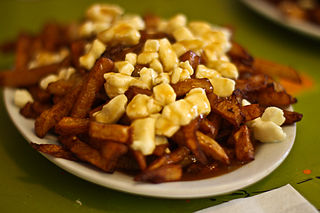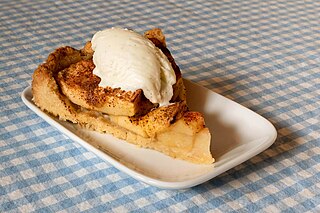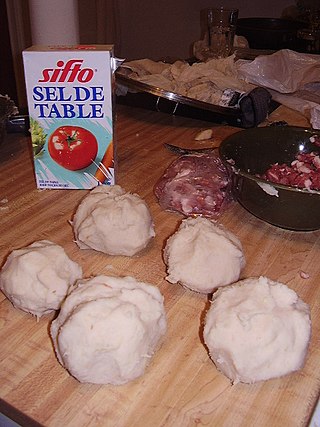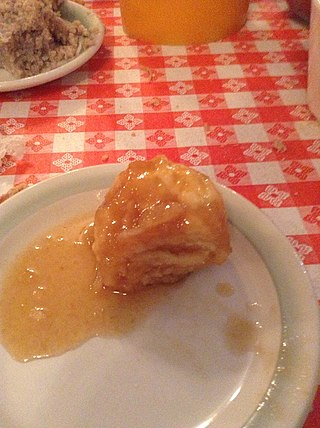
The cuisine of Québec is a national cuisine in the Canadian province of Québec. It is also cooked by Franco-Ontarians.

The tarte Tatin, named after the Tatin sisters who invented it and served it in their hotel as its signature dish, is a pastry in which the fruit is caramelized in butter and sugar before the tart is baked. It originated in France but has spread to other countries over the years.

Canadian cuisine consists of the cooking traditions and practices of Canada, with regional variances around the country. First Nations and Inuit have practiced their culinary traditions in what is now Canada for at least 15,000 years. The advent of European explorers and settlers, first on the east coast and then throughout the wider territories of New France, British North America and Canada, saw the melding of foreign recipes, cooking techniques, and ingredients with indigenous flora and fauna. Modern Canadian cuisine has maintained this dedication to local ingredients and terroir, as exemplified in the naming of specific ingredients based on their locale, such as Malpeque oysters or Alberta beef. Accordingly, Canadian cuisine privileges the quality of ingredients and regionality, and may be broadly defined as a national tradition of "creole" culinary practices, based on the complex multicultural and geographically diverse nature of both historical and contemporary Canadian society.

A butter tart is a type of small pastry tart highly regarded in Canadian cuisine. The sweet tart consists of a filling of butter, sugar, syrup, and egg, baked in a pastry shell until the filling is semi-solid with a crunchy top. The butter tart should not be confused with butter pie or with bread and butter pudding.

The Nanaimo bar is a bar dessert that requires no baking and is named after the Canadian city of Nanaimo in British Columbia. It consists of three layers: a wafer, nut, and coconut crumb base; custard icing in the middle; and a layer of chocolate ganache on top. Many varieties exist, consisting of various types of crumb, various flavours of icing, and various types of chocolate.

Apple cakes are cakes in which apples feature as a main flavour and ingredient. Such cakes incorporate apples in a variety of forms, including diced, pureed, or stewed, and can include common additions like raisins, nuts, and 'sweet' spices such as cinnamon or nutmeg. They are a common and popular dessert worldwide, thanks to millennia of apple cultivation in Asia and Europe, and their widespread introduction and propagation throughout the Americas during the Columbian Exchange and colonisation. As a result, apple desserts, including cakes, have a huge number of variations.

Flammekueche (Alsatian), Flammkuchen, or tarte flambée (French), is a speciality of the region of Alsace, German-speaking Moselle, Baden and the Palatinate. It is composed of bread dough rolled out very thinly in the shape of a rectangle or oval, which is covered with fromage blanc or crème fraîche, thinly sliced onions and lardons.

A lemon tart is a dessert dish, a variety of tart. It has a pastry shell with a lemon flavored filling.

Pouding chômeur is a dessert that was created during the early years of the Great Depression in Quebec, Canada.

Crème brûlée, also known as burnt cream or Trinity cream, and virtually identical to crema catalana, is a dessert consisting of a rich custard base topped with a layer of hardened caramelized sugar. It is normally served slightly chilled; the heat from the caramelizing process tends to warm the top of the custard, while leaving the center cool. The custard base is generally flavored with vanilla in French cuisine, but can have other flavorings. It is sometimes garnished with fruit.

Acadian cuisine comprises the traditional dishes of the Acadian people. It is primarily seen in the present-day cultural region of Acadia.Note 1 Acadian cuisine has been influenced by the Deportation of the Acadians, proximity to the ocean, the Canadian winter, bad soil fertility, the cuisine of Quebec, American cuisine, and English cuisine, among other factors.

Tarte tropézienne, also known as "la tarte de Saint-Tropez", is a dessert pastry consisting of a halved brioche filled with a mix of two creams, thick pastry cream and buttercream, and topped with pearl sugar. It was created in 1955 by Polish confectioner Alexandre Micka, a pâtisserie owner in Saint-Tropez, where he moved in 1945 just after the war.

Grand-pères, grand-pères au sirop d'érable or grand-pères dans le sirop d'érable is a traditional pastry in Québécois and Acadian cuisine. The term pépère is also used to describe this dish in some regions of Quebec like Beauce. This pastry is commonly served during "le temps des sucres" in sugar shacks.
This page is based on this
Wikipedia article Text is available under the
CC BY-SA 4.0 license; additional terms may apply.
Images, videos and audio are available under their respective licenses.













